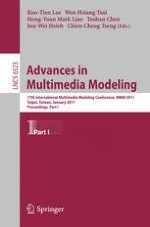This two-volume proceedings constitutes the refereed papers of the 17th International Multimedia Modeling Conference, MMM 2011, held in Taipei, Taiwan, in January 2011. The 51 revised regular papers, 25 special session papers, 21 poster session papers, and 3 demo session papers, were carefully reviewed and selected from 450 submissions. The papers are organized in topical sections on audio, image video processing, coding and compression; media content browsing and retrieval; multi-camera, multi-view, and 3D systems; multimedia indexing and mining; multimedia content analysis; multimedia signal processing and communications; and multimedia applications. The special session papers deal with content analysis for human-centered multimedia applications; large scale rich media data management; multimedia understanding for consumer electronics; image object recognition and compression; and interactive image and video search.
